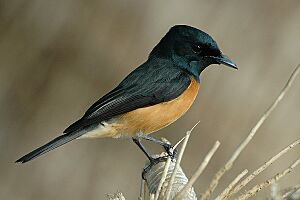Vanikoro flycatcher facts for kids
Quick facts for kids Vanikoro flycatcher |
|
|---|---|
 |
|
| male | |
| Conservation status | |
| Scientific classification | |
| Genus: |
Myiagra
|
| Species: |
vanikorensis
|
| Subspecies | |
|
See text |
|
| Synonyms | |
|
|
The Vanikoro flycatcher (Myiagra vanikorensis) is a small bird that belongs to the Monarchidae family. It is a type of monarch flycatcher. This bird lives in two main areas: on Vanikoro island in the southern Solomon Islands and in Fiji.
Contents
About the Vanikoro Flycatcher's Name
French scientists Jean Quoy and Joseph Gaimard first described the Vanikoro flycatcher in 1832. They found a specimen of the bird on Vanikoro island. They gave it the scientific name Platyrhynshos vanikorensis.
This bird is related to other flycatchers found on islands, like the Melanesian flycatcher and the Samoan flycatcher. It is also related to the leaden flycatcher from Australia. Sometimes, people call the Vanikoro flycatcher by other names, such as the red-bellied flycatcher.
Different Types of Vanikoro Flycatchers
There are five known types, or subspecies, of the Vanikoro flycatcher:
- M. v. vanikorensis: This type is found on Vanikoro island in the eastern Solomon Islands.
- M. v. rufiventris: You can find this type in northern, central, and southern Fiji.
- M. v. kandavensis: This type lives on Beqa, Vatulele, and Kadavu Island in south-western Fiji.
- M. v. dorsalis: This type is found in the northern Lau Islands and the Moala Islands in eastern Fiji.
- M. v. townsendi: This type lives in the southern Lau Islands in south-eastern Fiji.
What Does the Vanikoro Flycatcher Look Like?
The Vanikoro flycatcher is a small bird, about 13 centimeters (5 inches) long. It weighs around 13 grams, which is about the same as a few coins. It has a black beak that is slightly curved and black legs.
Male and female Vanikoro flycatchers look a bit different. This is called sexual dimorphism.
- Males have dark blue-black feathers on their head, throat, back, tail, and wings. Their belly is a faded red, and their rump (the area above the tail) is white.
- Females have similar patterns but are lighter in color. Their belly and throat are orange instead of red, and their other dark feathers are slate grey instead of dark blue.
Young birds look like females but have white patterns on their wings. The colors can also vary slightly depending on the specific subspecies. For example, the female of the dorsalis type has a white throat.
Where Do Vanikoro Flycatchers Live?
The Vanikoro flycatcher can live in many different places. It naturally lives in forests and at the edges of forests, from sea level up to 1100 meters high. These birds have also learned to live in areas changed by humans, like gardens and farms. They just need a few trees to be present.
What Do Vanikoro Flycatchers Eat?
These birds mostly eat insects. They catch insects by flying out from a perch, grabbing them in the air, or picking them from under leaves. This hunting style is called sallying. Besides insects, Vanikoro flycatchers also eat small lizards and tiny fruits.
They usually look for food in the tops of trees in untouched forests. However, in areas where humans have changed the environment, they will look for food in other places, even around buildings. They are quite curious birds!
Life Cycle and Reproduction
In Fiji, Vanikoro flycatchers build their nests and lay eggs from September to February. Their nest is a small cup made from plant fibers, grass stems, and roots. They decorate the outside with lichen and leaves and line the inside with animal hair. The nest is usually placed high up in a tree on a horizontal branch.
Both the male and female birds help build the nest. They also both take turns sitting on the eggs (this is called incubation) and raising the baby birds. A female usually lays 1 to 2 eggs, which are pinkish-white with small freckles.
If predators, like the Fiji goshawk or the local peregrine falcon, come near their nest, the Vanikoro flycatchers will bravely chase them away.
Is the Vanikoro Flycatcher in Danger?
The IUCN (International Union for Conservation of Nature) does not consider the Vanikoro flycatcher to be in danger. It is listed as a species of least Concern. This means there are plenty of them. They are still common across most of Fiji and can adapt well to changes humans make to their environment.
Images for kids



